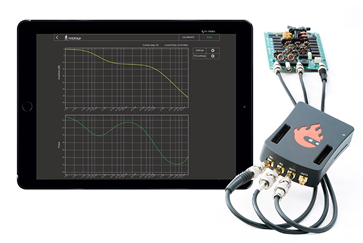Achieving Ultra-Stable Frequency Dissemination with Red Pitaya: A Fully Digital Doppler Cancellation Technique
- Posted by
 Red Pitaya Team
Red Pitaya Team

In the field of precision time and frequency distribution, maintaining ultra-stable signals over optical fiber links is crucial for advanced scientific research and technological applications. Researchers at the FEMTO-ST Institute in Besançon, France, have developed a novel approach to local ultra-stable frequency dissemination using a fully digital Doppler cancellation technique. Central to this innovation is the utilization of the Red Pitaya SDRlab 122-16, which offers a cost-effective and versatile platform for digital signal processing.
The Challenge of Fiber Link Noise
Optical fiber links are widely used for disseminating ultra-stable frequencies over various distances. However, environmental disturbances such as temperature fluctuations and mechanical vibrations introduce phase noise into the fiber, degrading the stability of the transmitted frequency. Active compensation methods are thus essential to mitigate this noise and maintain signal integrity.
A Digital Approach with Red Pitaya
The research team implemented a Doppler cancellation scheme based on a heterodyne Michelson interferometer setup. By using a single acousto-optic modulator (AOM) operating at 110 MHz, they created a system capable of canceling out the phase noise over a 90-meter-long fiber link at 1542 nm wavelength.
Key Components:
- Red Pitaya SDRlab 122-16: Serves as the digital processing unit for signal generation and noise correction.
- Acousto-Optic Modulator (AOM): Modulates the optical signal frequency to detect phase disturbances.
- Photodiodes (PD1 and PD2): Detect beat notes carrying phase noise information and monitoring signals.


Figure 1: Diagram of the Doppler cancellation setup.
Innovative Use of Sampling Properties
Traditional analog methods for handling frequencies outside the Nyquist baseband require additional mixers and multipliers, which can introduce environmental sensitivities. To overcome this, the team leveraged the sampling properties of digital electronics:
- Undersampling: The 220 MHz beat note signal is directly undersampled by the Red Pitaya, effectively bringing it within the processing capabilities of the device without additional hardware.
- Aliased Signal Generation: By exploiting the aliasing effect, the Red Pitaya generates an output that includes a spectral component at 110 MHz, necessary for the correction signal.
This approach simplifies the hardware requirements and enhances the system's robustness.
Characterization and Performance
An original characterization method was developed to measure the disturbance rejection and optimize the noise cancellation performance, even when the remote end of the fiber is inaccessible. By adjusting the proportional-integral (PI) gains within the Red Pitaya's digital processing, the system achieved remarkable frequency stability.
Results:
- Closed-Loop Stability: The system maintained a fractional frequency stability in the order of 10^-18 integration times.
- Comparison Scenarios: Tests were conducted with the 90-meter fiber link, a shorter 1-meter link, and a setup without the physical fiber and AOM, demonstrating the effectiveness of the digital cancellation in various conditions.


Figure 2: Fractional frequency stability measurements under different configurations.
Implications and Future Work
The successful implementation of a fully digital Doppler cancellation technique using the Red Pitaya platform marks a significant advancement in local ultra-stable frequency dissemination. This innovative setup not only simplifies the hardware requirements but also delivers high performance, making it well-suited for precise scientific applications. Moving forward, there are several promising enhancements to consider. With minor adjustments, the system has the potential to be adapted for longer fiber links, thereby broadening its range of applicability. Additionally, incorporating a second acousto-optic modulator (AOM) at the remote end of the fiber could further discriminate against undesirable reflections, significantly enhancing the integrity of the transmitted signal. These improvements would not only increase the system's robustness, but also extend its utility across a wider array of research and industrial applications.
Why Red Pitaya Was the Ideal Choice
The Red Pitaya SDRlab 122-16 provided an optimal solution due to its:
- High-Performance Analog Inputs and Outputs: Necessary for handling high-frequency signals with precision.
- Flexible Digital Processing Capabilities: Enabled the innovative use of undersampling and aliasing.
- Cost-Effectiveness: Offered a budget-friendly alternative to expensive specialized equipment.
- Open-Source Platform: Allowed for customizable programming to meet specific research needs.
Conclusion
This project showcases the potential of digital electronics and platforms like Red Pitaya in advancing the field of ultra-stable frequency dissemination. By adopting fully digital techniques, researchers can achieve high levels of performance while simplifying system design and reducing costs, making such projects more efficient and accessible.






